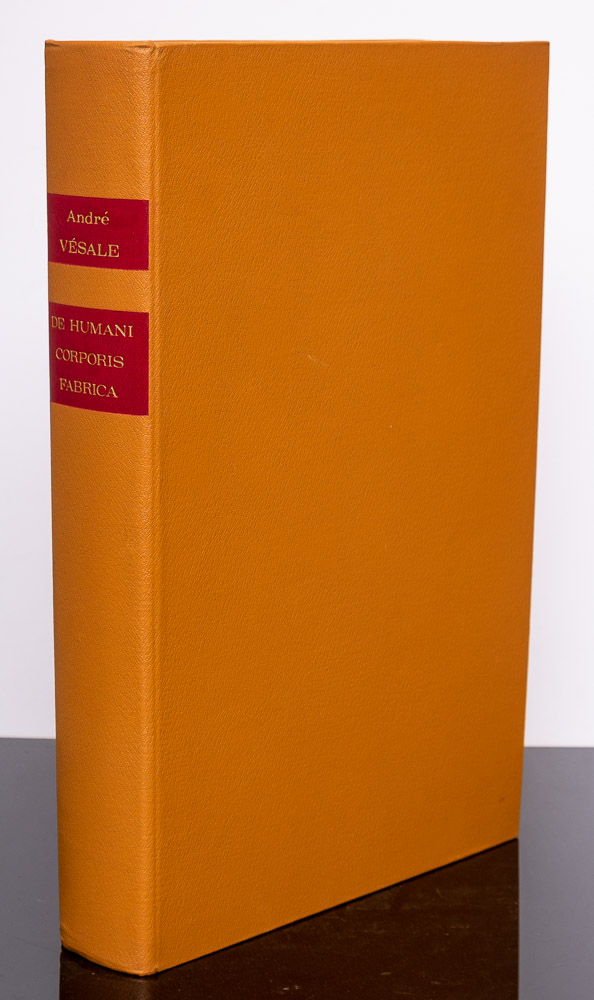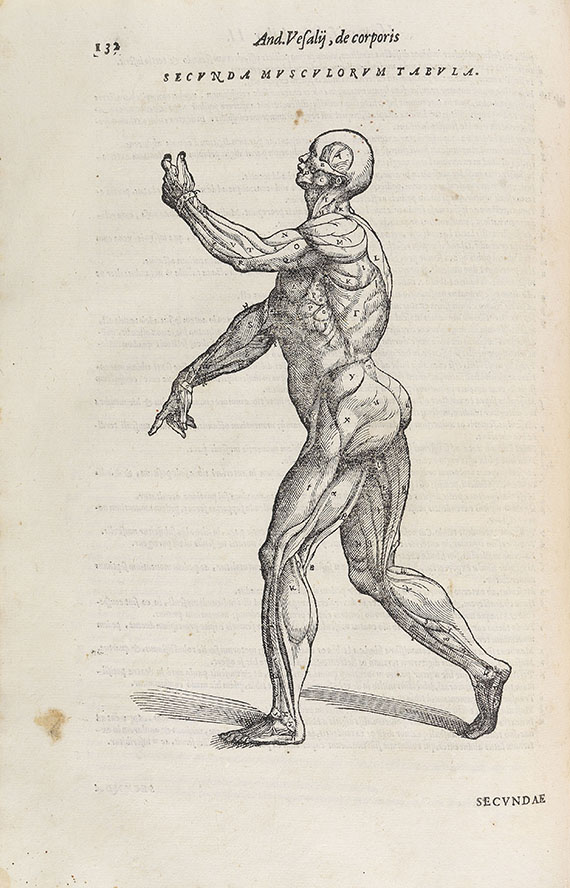VESALIUS, Andreas (1514-64). De humani corporis fabrica libri septem . Basel: Johannes Oporinus, June 1543. 2 (420 x 277 mm). Collation: * 6; A-Z 6 a-l 6 m 6(2+1, 2+1 + fold-out sheet, both signed m3) n-o 6 p 4(3 + fold-out sheet signed p4) q-z 6 Aa-Ll 6 Mm 8. 355 leaves and two folding sheets. Roman and italic types, occasional use of Greek and Hebrew types, printed shoulder notes. Woodcut pictorial title, author portrait, and printer's device; 7 large, 186 mid-sized, and 22 small woodcut initials; more than 200 woodcut illustrations, including 3 full-page skeletons, 14 full-page muscle-men, 5 large diagrams of veins and nerves, 10 mid-sized views of the abdomen, 2 mid-sized views of the thorax, 13 mid-sized views of the skull and brain, and numerous smaller views of bones, organs and anatomical parts; ALL WOODCUTS AND INITIALS WITH FULL CONTEMPORARY COLORING AND HIGHLIGHTS IN LIQUID GOLD AND SILVER. (m2+1 and the attached fold-out sheet extended at lower margin and possibly inserted from another copy, fold-out sheet p4 strengthened along fold on verso, one-line typographical imprint below title cut obscured by priming for the miniature, some dampstaining and spotting, lower outer corner of title leaf restored, some minor marginal repairs and a few paper flaws.) Contemporary purple silk velvet over pasteboard, spine in six compartments, evidence of four pairs of blue silk ties, vellum linings (worn and frayed, defective at tail of spine); modern black morocco box. Provenance : Charles V (1500-58), Holy Roman Emperor, probably the dedication copy given to him by Vesalius in 1543 (inscription, coloring, binding); Jacques Mesnage (1509-56), French ambassador to the imperial court (early French inscription on flyleaf: "Ce Liure a est donn par lempereur Charles le quint a Messire Jacques Mesnage cheualier seigneur et patron de Cagny Ambassadeur Du Roy de France Francois premier aupres de sa personne"); Comte de Nicholay (Librairie Thomas-Scheler, cat. 3, no. 261). FIRST EDITION, THE ONLY COMPLETELY COLORED COPY KNOWN, PROBABLY THE DEDICATION COPY TO THE HOLY ROMAN EMPEROR CHARLES V Vesalius was born in Brussels, the son of an imperial apothecary, and the descendent of several physicians. After studying in Louvain and Paris, he completed his bachelor's degree at Louvain, publishing a thesis on the comparison of Muslim and Galenic therapy, Paraphrasis in nonum librum Rhazae ad regem Almansorem (Louvain, 1537). In Paris he studied anatomy under Johann Guenther von Andernach, who mentioned Vesalius in his Institutiones anatomicae (see lots 107 and 211), a dissection manual for medical students which Vesalius later revised. Vesalius criticized Guenther: "I do not consider him an anatomist, and I should willingly suffer him to inflict as many cuts upon me as I have seen him attempt on man or any other animal -- except at the dinner table." Nevertheless, Vesalius acquired an interest in anatomy which he pursued on his return to Louvain, as attested by the story of his robbing a corpse from a gibbet outside the city in order to obtain the skeleton, one of several he articulated during his career. In 1537 he matriculated at the University of Padua, an important center of medical instruction, and after taking examinations, was immediately awarded the degree of doctor and appointed to teach surgery and anatomy. During the next several years, he published several works, including a set of anatomical charts for the use of his students ( Tabulae anatomicae sex , Venice 1538), his revision of Guenther von Andernach (lot 211), and the enesection Letter (lot 212). By this time he had also begun work on his masterpiece. "With De humani corporis fabrica , published when he was only twenty-nine years old, Vesalius revolutionized not only the science of anatomy but also how it was taught" (Grolier Medicine ). In contradiction to the common practice of his day, Vesalius insisted that human anatomy should be learned from the study of the human bod
VESALIUS, Andreas (1514-64). De humani corporis fabrica libri septem . Basel: Johannes Oporinus, June 1543. 2 (420 x 277 mm). Collation: * 6; A-Z 6 a-l 6 m 6(2+1, 2+1 + fold-out sheet, both signed m3) n-o 6 p 4(3 + fold-out sheet signed p4) q-z 6 Aa-Ll 6 Mm 8. 355 leaves and two folding sheets. Roman and italic types, occasional use of Greek and Hebrew types, printed shoulder notes. Woodcut pictorial title, author portrait, and printer's device; 7 large, 186 mid-sized, and 22 small woodcut initials; more than 200 woodcut illustrations, including 3 full-page skeletons, 14 full-page muscle-men, 5 large diagrams of veins and nerves, 10 mid-sized views of the abdomen, 2 mid-sized views of the thorax, 13 mid-sized views of the skull and brain, and numerous smaller views of bones, organs and anatomical parts; ALL WOODCUTS AND INITIALS WITH FULL CONTEMPORARY COLORING AND HIGHLIGHTS IN LIQUID GOLD AND SILVER. (m2+1 and the attached fold-out sheet extended at lower margin and possibly inserted from another copy, fold-out sheet p4 strengthened along fold on verso, one-line typographical imprint below title cut obscured by priming for the miniature, some dampstaining and spotting, lower outer corner of title leaf restored, some minor marginal repairs and a few paper flaws.) Contemporary purple silk velvet over pasteboard, spine in six compartments, evidence of four pairs of blue silk ties, vellum linings (worn and frayed, defective at tail of spine); modern black morocco box. Provenance : Charles V (1500-58), Holy Roman Emperor, probably the dedication copy given to him by Vesalius in 1543 (inscription, coloring, binding); Jacques Mesnage (1509-56), French ambassador to the imperial court (early French inscription on flyleaf: "Ce Liure a est donn par lempereur Charles le quint a Messire Jacques Mesnage cheualier seigneur et patron de Cagny Ambassadeur Du Roy de France Francois premier aupres de sa personne"); Comte de Nicholay (Librairie Thomas-Scheler, cat. 3, no. 261). FIRST EDITION, THE ONLY COMPLETELY COLORED COPY KNOWN, PROBABLY THE DEDICATION COPY TO THE HOLY ROMAN EMPEROR CHARLES V Vesalius was born in Brussels, the son of an imperial apothecary, and the descendent of several physicians. After studying in Louvain and Paris, he completed his bachelor's degree at Louvain, publishing a thesis on the comparison of Muslim and Galenic therapy, Paraphrasis in nonum librum Rhazae ad regem Almansorem (Louvain, 1537). In Paris he studied anatomy under Johann Guenther von Andernach, who mentioned Vesalius in his Institutiones anatomicae (see lots 107 and 211), a dissection manual for medical students which Vesalius later revised. Vesalius criticized Guenther: "I do not consider him an anatomist, and I should willingly suffer him to inflict as many cuts upon me as I have seen him attempt on man or any other animal -- except at the dinner table." Nevertheless, Vesalius acquired an interest in anatomy which he pursued on his return to Louvain, as attested by the story of his robbing a corpse from a gibbet outside the city in order to obtain the skeleton, one of several he articulated during his career. In 1537 he matriculated at the University of Padua, an important center of medical instruction, and after taking examinations, was immediately awarded the degree of doctor and appointed to teach surgery and anatomy. During the next several years, he published several works, including a set of anatomical charts for the use of his students ( Tabulae anatomicae sex , Venice 1538), his revision of Guenther von Andernach (lot 211), and the enesection Letter (lot 212). By this time he had also begun work on his masterpiece. "With De humani corporis fabrica , published when he was only twenty-nine years old, Vesalius revolutionized not only the science of anatomy but also how it was taught" (Grolier Medicine ). In contradiction to the common practice of his day, Vesalius insisted that human anatomy should be learned from the study of the human bod















Try LotSearch and its premium features for 7 days - without any costs!
Be notified automatically about new items in upcoming auctions.
Create an alert